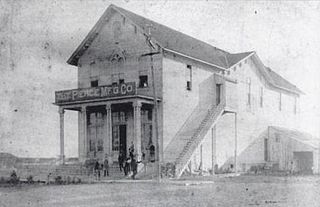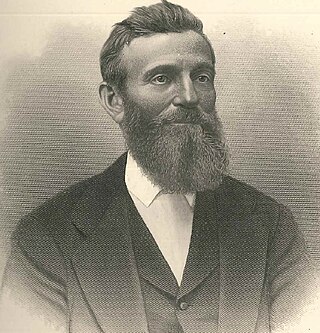Edward Augustus Foster (also Edward A. Foster and A.E. Foster) was a nineteenth century businessman and lumber tycoon known for helping to develop various lumber businesses.
Edward Augustus Foster (also Edward A. Foster and A.E. Foster) was a nineteenth century businessman and lumber tycoon known for helping to develop various lumber businesses.
Edward was born in Machias, Maine on August 10, 1830. His parents were Edward Foster and Fannie (Cilley) Foster. While growing up he spent most of his youth as a helper in his father's sawmills instead of going to a public school for formal training. Edward stayed with his parents until he was twenty years old. [1] [2]
Edward went to Boston in 1850 and became employed as a crew member on a vessel heading to Puget Sound, Washington. The ship had sawmill machinery purchased by the lumber firm Pope & Talbot. The trip took six months and ended at Port Gamble, Washington. The equipment that the vessel carried was unloaded and set up as a sawmill. Edward, as an employee of the lumber firm, helped set up this sawmill as the first on the Pacific coast of the United States. [3] [4]
Edward left Pop & Talbot in 1853 and traveled back east to Oshkosh, Wisconsin. He ran a lumber business there with his brother Luther starting around 1855 and continued that until 1857. They then moved to Stiles, Wisconsin at Green Bay. There they worked as foremen for Holt & Balcom, Iverson & Whitcomb, and the Holt Lumber Company for seven years. [5] [6]
Edward with his brother Luther crossed Lake Michigan in 1865 and went to Muskegon, Michigan where they worked for S. N. Wilcox as foremen for about a year. They then went north to the village of Pere Marquette in northwestern Michigan. The village later became the town of Ludington, Michigan. Edward bought into the Pere Marquette Lumber Company with his brother when it was organized in 1866. Other partners of the new lumber company were D.L. Filer, John Mason Loomis, John McLaren, and James Ludington. Edward sold his part in the Pere Marquette Lumber Company in 1872 and formed the company Foster & Stanchfield. He sold his ownership part in this firm in 1876 and in 1877 started a new company called E.A. Foster & Company and manufactured shingles. Edward left the field in 1881 for about a year due to poor health. Then in 1883 he purchased T.H. Sheppard's interest in the lumber firm A.R. Gray & Company in Chicago. He was associated with that firm with his son Harry through 1884. [7]
Edward with his son Harry bought into the McDonald Lumber Company at Wausau, Wisconsin in 1885 and sold it 1886. Then he formed the Merrill Lumber Company. This company took over the sawmill ownership of the Lincoln Lumber Company at Merrill, Wisconsin. It included a large tract of white pine timber. They began to produce lumber with the sawmill. Edward was president of the company they formed in 1888 and a manager in the Merrill Boom Company. Edward was one of the partners and original managers of the Red Cliff Lumber Company. They manufactured lumber at Redcliff, Wisconsin. [8]
Edward had married a childhood friend in 1856, Laura Helen. They raised six children. Laura died in 1898. Edward died December 21, 1902. At that time he had ownership in the Arkansas Land & Lumber Company, the Wisconsin & Arkansas Lumber Company, and the Wausau Everett Investment Company in Washington. [9]

Ludington is the largest city and county seat of Mason County in the U.S. state of Michigan. As of the 2010 census, the city population was 8,076.
Pere Marquette or Jacques Marquette (1637–1675) was a French Jesuit missionary and namesake of Marquette University.
The Flint and Pere Marquette Railroad (F&PM) is a defunct railroad which operated in the U.S. state of Michigan between 1857 and 1899. It was one of the three companies which merged to become the Pere Marquette Railway.
The White River Railroad was a wholly owned subsidiary of the Chicago and West Michigan Railroad incorporated on November 13, 1879, for the purpose of constructing a rail link north from the C&WM's line at White Cloud to the Flint and Pere Marquette Railroad's main line (Ludington–Monroe) at Baldwin, and to exploit the ample timber resources of the White River area. On April 1, 1880, the White River opened a 13-mile (21 km) line from White Cloud north to Merrill Township, in Newaygo County. In 1881 the line was extended a further 4 miles (6.4 km) to what would become Bitely in 1889. In either late 1883 or no later than February 7, 1884, the White River completed the line all the way to Baldwin, for a total length of 29.86 miles (48.06 km).

Aaron Burr Caswell (1807–1896) was an American frontiersman and the first white man to occupy any part of Mason County, Michigan. He became the county's first coroner, probate judge and surveyor; and constructed its first framed building that functioned as a home, courthouse and jail—it is also the only surviving landmark of Mason County's earliest history. Caswell was also the progenitor of a prominent Mason County family.

James Ludington was an American entrepreneur, businessman, lumber baron, and real estate developer. As a businessman he would loan money to other businessmen. In one such loan he had to foreclose for delinquent payments on a sawmill operation in Michigan. He ultimately obtained the sawmill in the village of Pere Marquette. Ludington platted the land there and formed a town with a lumber company operation. He sold his interest to the lumber company for a large sum of money and became wealthy. The town later changed its name and became Ludington, Michigan, although he never lived there.

The Ludington Public Library is one of the two branches of the Mason County District Library administrative system. This library, as the main branch, is located in downtown Ludington, in Mason County in the Lower Peninsula of Michigan. The library started as in 1872 as an association. A 90-day trial for a free reading room was undertaken; later a small structure was acquired for a definitive reading room.

Eber Brock Ward was an American industrialist, iron and steel manufacturer, and shipbuilder. He was known as the "steamship king of the Great Lakes" and the "first of the iron kings." Ward became Detroit's first millionaire. His steel factories made him, in his time, the wealthiest man in the Midwest.

Antoine Ephrem Cartier was a 19th-century American businessman who assisted in the development of Ludington, Michigan. He was a business owner, stock speculator, lumber tycoon, sawmill owner, and real estate investor. He was mayor of Ludington from 1880 through 1888 and progenitor of a line of mayors sharing his Cartier name.

Warren Antoine Cartier was a 19th-century northern Michigan businessman who helped establish Ludington, Michigan. He was twice elected mayor of the city and was the owner of several businesses, a banker, a lumber tycoon, a sawmill owner/operator, and a real estate investor. In civic life, he was involved with many societies and organizations.

Justus Smith Stearns was an American lumber baron and businessman. He was involved in many enterprises that involved commercial real estate development, sawmills, coal mining and sales, farming, railroading, and electrical technology. He started his lumber pursuits as a teenager at his father's sawmills. This expereience and business knowledge. learned from his father, led to his becoming a lumber merchant in his twenties.
The Mason and Oceana Railroad (M&O) was a short common carrier, 3 ft narrow gauge logging railroad in the U.S. state of Michigan. Organized in 1887 and in operation from 1887 until 1909, it served the counties of Mason and Oceana in the northwestern quarter of Michigan's Lower Peninsula in the late 19th and early 20th centuries.

Lewis Ludington was a real estate developer and the founder of Columbus, Wisconsin. He was an American businessman of the nineteenth century that had general merchandising stores in Milwaukee and New York state for decades. Ludington was a lumber baron and operated lumber mills and boat docks in Wisconsin to transport his manufactured lumber to New York to be used for construction. He never lived in Wisconsin, but contributed much to its economy.

Nelson Ludington was a nineteenth-century American businessman, lumber baron and banker. Born in Ludingtonville, New York, he made his fortune in the Midwest based on resource exploitation: lumber, iron ore and copper.

The SS Pere Marquette was the world's first steel train ferry. It sailed on Lake Michigan and provided a service between the ports of Ludington, Michigan, and Manitowoc, Wisconsin, for the Pere Marquette Railway from 1897 to 1930. The railway used the name Pere Marquette for many of its ships and ferries, adding a number to the end of the name.

Robert Logan was a Scottish naval architect. He was a university graduate of mathematics, science, and engineering. Logan designed and constructed several large ships for various shipbuilding firms worldwide. His first ones were passenger cruise excursion boats and later constructed freighter ships for the American Shipbuilding Company that carried railroad trains across Lake Michigan. He designed the world's first steel train ferry, followed by several more Logan boats that ultimately developed into the world's largest carferry fleet that operated out of Ludington, Michigan.

The Pere Marquette Lumber Company was a lumber, salt, sawyering and merchandising company of the nineteenth century. Its initial purpose was as an asset management company. The holdings were that of James Ludington, a lumber baron. The business firm was the cradle for the development of the city of Ludington, Michigan. The company was an important component of the lumber boom and bust in the area, supplying lumber for hundreds of thousands of homes and other structures in the Midwest. It was one of the largest producers of salt in the state of Michigan. The company was active from 1869 to 1897 and later sold.

Luther Hall Foster was a nineteenth century businessman and lumber tycoon known for helping to develop various lumber businesses.

John Mason Loomis was a nineteenth-century American businessman and lumber tycoon from Chicago who was known for developing the city of Ludington, Michigan. He was involved with the Pere Marquette Lumber Company, which also operated salt distilleries that in turn influenced the salt industry of northern Michigan. The village of Pere Marquette benefited from these local industries and developed into the city Ludington.

Delos L. Filer was a businessman famous for developing Manistee County and the towns of Manistee, Filer City and Ludington in the state of Michigan. He owned sawmills and related businesses and was a physician, a merchant, a lumber baron, a real estate developer, and a philanthropist.
Mr. Foster assisted in setting up what is believed to have been the first sawmill on the Pacific coast, entering the employ of Pope & Talbot, with whom he continued there for two years.
It is believed to have been the first sawmill in the western wilderness of forests washed by the waters of the Pacific Ocean